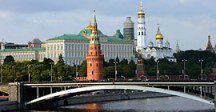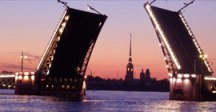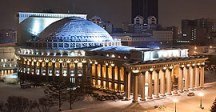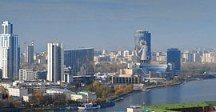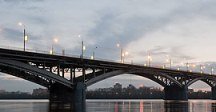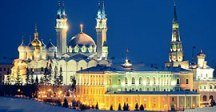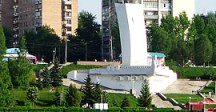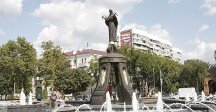Map of Kolomna
Detailed interactive map of Kolomna. Map of Kolomna with streets and numbers of houses. Satellite map of Kolomna with sights of the city.
The change between the satellite map of Kolomna and the schematic one is made in the lower left corner of the interactive map.
Kolomna
The population of the city Kolomna: 138,693 people (2021)
The telephone code of the city Kolomna: +7 496 6
Kolomna city car code: 50, 90, 150, 190
Postal code of Kolomna: 140400-140415
In the Moscow region, about 110 km from Moscow, there is the city of Kolomna, which is washed by the waters of the Oka. The first mention of this settlement dates back to 1177, when Kolomna was known as the great port of the Ryazan Principality.
Since those medieval times, numerous historical monuments have been preserved in the city. For example, the ruins of the stone Kremlin, which centuries ago was one of the most powerful fortifications in Russia and had 17 towers.
A beautiful place in Kolomna is Cathedral Square with its Orthodox buildings: Assumption Cathedral, Holy Cross Church and Tikhvin Temple. There is also a military monument in the city – a memorial park full of monuments to the victims of the war and having its own eternal flame. Of the cultural institutions, the Ozerov House is considered the main one – a cultural, exhibition and concert hall.
What to see in Kolomna
The Church of the Archangel Michael is the largest church in Kolomna. It was built between 1820 and 1833 in the Empire style, replacing an earlier version. The lower part of the bell tower dates back to the second half of the 18th century, when it was built next to the original stone church.
Just outside the Kremlin, next to the Kolomna Tower, there is a statue of Dmitry Donskoy on horseback and in full combat gear. The statue was unveiled in 2007, and taking into account its pedestal, the height is 12 meters. Dmitry has a special connection with Kolomna, since it was here that he got married and from here went to the Battle of Kulikov.
The museum of the Kolomna Pastille Factory was opened in 2011 and is located in the pastille factory founded by Pyotr Chuprikov in 1852. You can visit the museum as part of an excursion that explains the process of making marshmallows in the traditional way.
In the past, Kolomna had so many apple orchards that they were used to make sweet apple-flavored lozenges. Over time, Kolomna's fame for these lozenges spread throughout the empire. Now there are two museums in the city dedicated to this local delicacy.
Kolomna Memorial Park is located on the site of the mass grave of soldiers who died at the front or in Kolomna hospitals during World War II. An alley lined with busts of local war heroes runs through it.
The Museum of Military Glory was opened in May 2010 to commemorate the 65th anniversary of the end of World War II. The museum is dedicated to the residents of Kolomna who took part in various wars and military conflicts, and includes an electronic memory book containing the names of the heroes. The museum has exhibitions dedicated to the military history of the city as a whole, but they are mainly devoted to the Second World War.
The Church of Saints Peter and Paul dates back to 1779, when it was built at the Peter and Paul Cemetery, which, in turn, was opened in 1775 after a cholera epidemic broke out in the region, and Catherine the Great forbade the burial of cholera victims in city cemeteries. The church is built in the Baroque style with a small white stone cubic church attached to a red brick vestibule with a black dome.
The original church of St. John the Apostle was a wooden church located in the Kremlin. When it burned down in the 18th century, it was decided to rebuild it from stone in the classical style, this time outside the Kremlin in its current location. Work began in 1733, but was completed only in 1756 after several interruptions. The most striking feature of the church is the huge 67-meter bell tower, built in 1865 in the Empire style.
It is believed that the Church of St. John the Baptist dates back to the 14th century, which makes it one of the oldest buildings not only in Kolomna, but also in the Moscow region. The oldest part of the church is a cubic building built of white stone in the 16th century. In 1780, a small bell tower was added.
On the very outskirts of Kolomna is the Old Golutvin Monastery. It was founded in 1385 (or perhaps in 1374) by St. Gregory Golutvin, a disciple of St. Sergius of Radonezh, at the request of St. Sergius and Dmitry Donskoy. St. Sergius really played a significant role in its foundation, choosing a place near the place where the Moscow River flows into the Oka, and dedicating the first church to the Epiphany.
The main cathedral of the Kremlin is the Assumption Cathedral. The original Assumption Cathedral was built in 1379 by order of Grand Duke Dmitry Ivanovich. It was here that Grand Duke Dmitry Ivanovich prayed before his victory in the battle of Kulikovo Field, where he earned the epithet "Donskoy". The cathedral houses a revered copy of the icon of the Mother of God of the Don, which was presented to Dmitry Donskoy by the Don Cossacks before the battle.
Of the seven surviving towers of the Kremlin, four are located on the eastern side. From north to south there are Pogorelaya (Alekseevskaya), Spasskaya, Semenovskaya and Yamskaya (Troitskaya) Towers, which all have a square shape. The walls that once ran between these towers have not been preserved, except for a section of the wall attached to the Yamskaya Tower.
The Church of the Exaltation of the Holy Cross is located on a site that was once the shopping center of the city. The current building was built in the Empire style between 1832 and 1837, replacing an earlier version of the church. Previously, a city copy of the icon of the Mother of God of the Don was kept here until 1825. In Soviet times, the bell tower and dome were destroyed and restored only in the 1990s.
The tallest tower of the Kremlin that has survived to this day is the Kolomna Tower, whose height is 31 meters. The tower was used to monitor the western part of the city and had 27 firing points. A spiral staircase leads inside the tower. It is often also called the Marinka Tower, since, according to legend, Marina Mnishek was imprisoned here, who was briefly the queen during the time of Troubles. The longest preserved part of the Kremlin walls runs from the Kolomna Tower to the Faceted Tower.
Pyatnitsky Gate used to serve as the main entrance to the Kremlin. The gate was built between 1525 and 1531, and its tower is 29 meters high and 13 meters thick. The front and back of the tower are decorated with an icon. There are two monasteries on the territory of the Kremlin.
The Tikhvin Cathedral of the Blessed Virgin Mary was built between 1858 and 1861 to replace an earlier version dating from 1776. It is a beautiful red and white cathedral with five domes. The Kremlin bell tower adjoins the cathedral, on which a 6,400 kg bell named Pimen, made in Voronezh, is installed.
The Kolomna Museum of Local Lore was recently moved and is now located in the Kremlin in the Kolchinsky estate. The main building consists of two floors: temporary exhibitions are held on the ground floor, while on the upper floor there are permanent exhibitions dedicated to the history of the city from ancient times to the present day. The staircase and hallway are also decorated with paintings of the city.
The Resurrection Church was built between 1780 and 1789 to replace an older version of the church, which was one of the first stone buildings in Kolomna. It was in the original version of the Resurrection Church that Dmitry Donskoy is supposed to have married the Suzdal princess Evdokia Dmitrievna. In the 19th century, a new classical-style lobby was added.
Inside the Kremlin there is a statue of Saints Cyril and Methodius. Saints Cyril and Methodius were brothers from Byzantium who went on a mission to convert the Southern Slavs to Orthodoxy. To translate the Bible into the local language, Saint Cyril invented the alphabet, which later turned into the Cyrillic alphabet, the alphabet of modern Russian and other Slavic languages. This monument was opened in 2007 as part of the celebration of the Day of Slavic Writing.
The sights of Kolomna
Kolomna Kremlin, Cathedral Square, Pyatnitsky Gate, Museum "Kolomna pastille", Museum of flax and life of a Russian woman, Museum – estate "House of samovar", Kolomna Museum of Local Lore, Museum "Kalachnaya", Museum "Kuznechnaya Sloboda", Cultural center "House of Ozerov", Estate of merchants Lazhechnikov, Staro – Golutvin monastery, Bobrenev Monastery, Holy Trinity Monastery, St. Nicholas Church on Posad, Monument to the Water Carrier, Shevlyaginskaya basin, Museum of Organic Culture, Assumption Brusensky Monastery.
The largest cities in Russia:
2024 © Russia-Karta.ru
